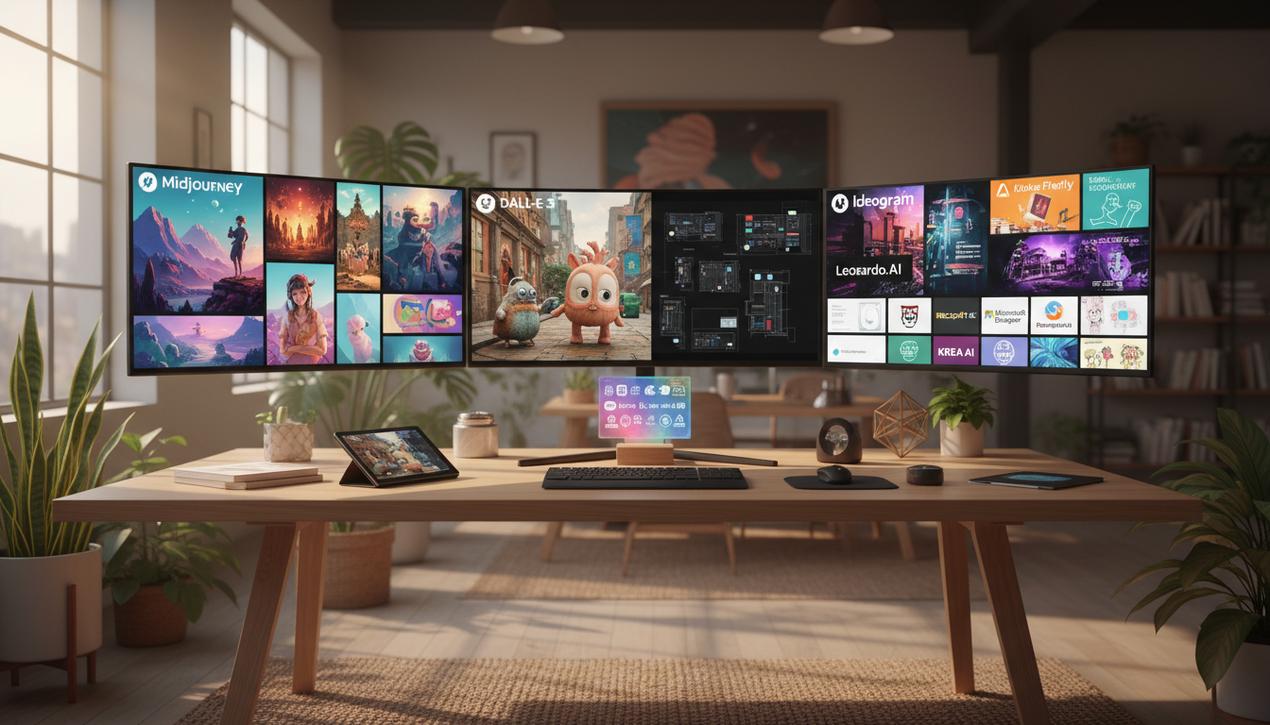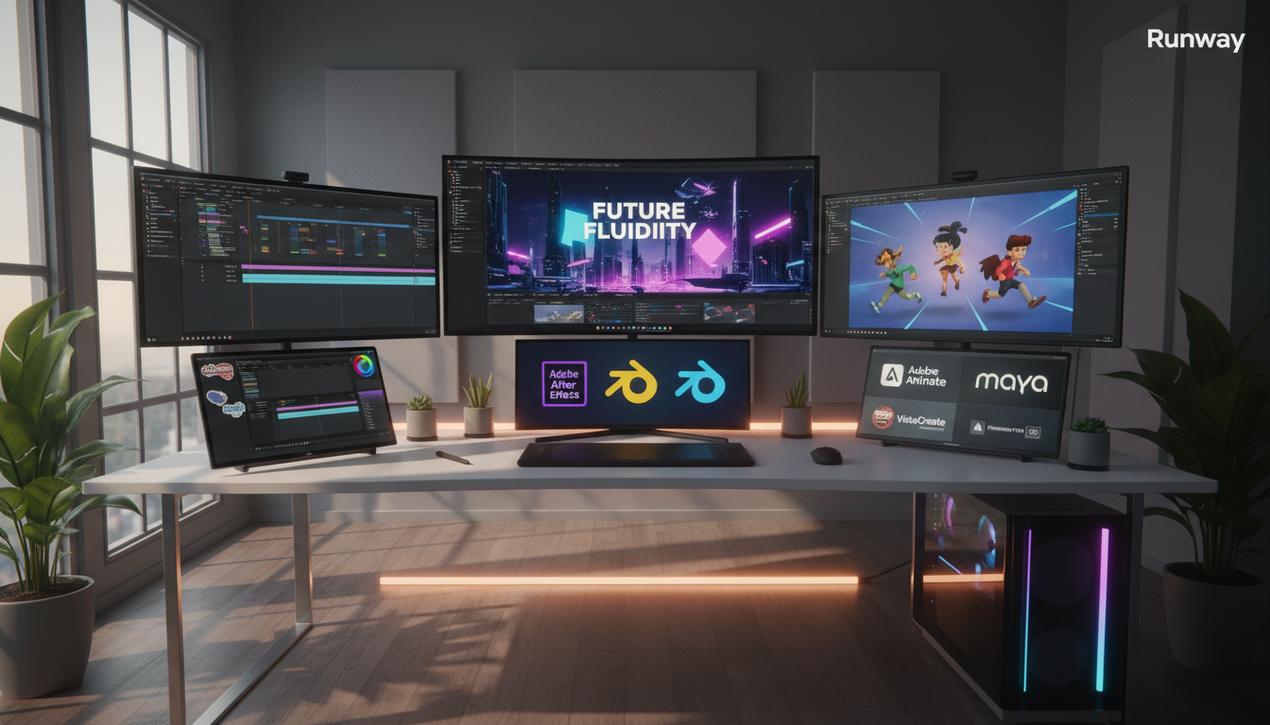Best AI Image Generators: The Ultimate 2025 Guide


Artificial intelligence image generation has exploded, radically transforming the fields of graphic design, marketing, and creative arts. In 2025, the generative AI market is projected to surge past $60 billion, a staggering growth that highlights its mass adoption. Every day, over 34 million images are created using text-to-image AI, pushing the boundaries of imagination. These tools, once experimental novelties, have become strategic assets for content creators, designers, and businesses, enabling the production of unique, high-quality visuals in seconds. Whether you need to illustrate a blog post, design prototypes for an ad campaign as part of a strategic marketing plan for 2025, or simply bring a creative concept to life, there is now an AI image generator perfectly suited to your needs.
With a plethora of options available, choosing the right tool can be overwhelming. This comprehensive guide is designed to provide clarity. We have analyzed and ranked the most powerful and innovative platforms on the market, from industry titans like Midjourney and DALL-E 3 to specialized challengers like Ideogram and Krea AI. We will cover the essential criteria for making your choice, the strengths and weaknesses of each solution, and the key trends shaping the future of AI-assisted visual creation. Prepare to explore a world where your words are transformed into stunning imagery.
How to Choose the Right AI Image Generator
Before you begin, it’s essential to define your needs. Not all generators are created equal; they excel in different areas. Here are the key criteria to evaluate to find the platform that’s right for you.
1. Quality and Visual Style
The most important factor is the AI’s ability to produce high-quality images that align with your creative vision. Some models excel at photorealism (like Midjourney or DALL-E 3), while others are better suited for specific artistic styles like illustration, concept art, or vector graphics (like Leonardo.AI or Recraft).
2. Ease of Use and Workflow
The user interface plays a major role in adoption. Platforms like Microsoft Designer or Canva integrate AI in a very intuitive way, making them ideal for beginners. Others, such as Midjourney (which operates through Discord) or a local installation of Stable Diffusion, have a steeper learning curve but offer far greater control for advanced users.
3. Pricing Model
The cost structures vary significantly. Common models include:
- Freemium: Ideal for testing, usually offering a limited number of daily or monthly credits and basic features (e.g., SeaArt, Playground AI).
- Subscription: The most common model, providing a set number of fast-generation credits per month for a recurring fee (e.g., Midjourney, Leonardo.AI).
- Pay-as-you-go Credits: Offers flexibility for occasional use, where you purchase credit packs as needed (e.g., Adobe Firefly).
4. Advanced Features
For professional use, certain features are indispensable. These include the ability to edit part of an image (inpainting), expand an image’s canvas (outpainting), maintain character consistency across multiple visuals, or train the AI on your own custom style.
5. Usage Rights and Ethical Considerations
Always check the terms of service regarding image ownership. Most platforms grant you commercial rights to the images you create. However, questions around the copyright of the AI’s training data persist. Tools like Adobe Firefly address this by guaranteeing their model is trained on a fully licensed database (Adobe Stock), providing legal peace of mind for commercial projects.
The Powerhouses: Top-Tier Professional Tools
These platforms are the market leaders, renowned for the exceptional quality and power of their models. They are the preferred choice for professionals and creatives who demand the best results.
Midjourney
Best for: Unmatched artistic quality and photorealism.
Midjourney is the benchmark for aesthetic excellence. Accessed via the chat app Discord, it produces images with a richness, depth, and stylistic coherence that few can match. Its latest versions excel at creating hyper-realistic scenes, stunning portraits, and complex artistic compositions. While its Discord-based interface can be unintuitive for newcomers, mastering its parameters unlocks immense creative control.
DALL-E 3 (via ChatGPT Plus or Microsoft Designer)
Best for: Natural language understanding and prompt accuracy.
Developed by OpenAI, DALL-E 3’s greatest strength is its phenomenal ability to understand long, complex text descriptions (prompts). It can follow detailed instructions with remarkable fidelity, making it the best tool for turning a specific, detailed idea into a coherent visual. Its integration into ChatGPT Plus and the free Microsoft Designer makes it both powerful and highly accessible.
Stable Diffusion
Best for: Flexibility, control, and open-source customization.
Stable Diffusion is not just a service; it’s an open-source model. This allows advanced users to run it on their own computers (with a powerful GPU) and customize it endlessly. The community has created thousands of fine-tuned models (checkpoints) that can generate images in virtually any style imaginable. Many web platforms, like Playground AI, are also built on Stable Diffusion.
Adobe Firefly
Best for: Professional workflow integration and legal safety.
Designed for creative professionals, Firefly is deeply integrated into the Adobe ecosystem (Photoshop, Illustrator, Express). Its standout feature is that it was trained exclusively on Adobe Stock’s library and public domain content, making it “commercially safe.” Features like Generative Fill in Photoshop have revolutionized photo editing and manipulation.
Top Platforms for Creators and Accessibility
These tools offer an excellent balance of power, ease of use, and generous free tiers, making them perfect for content creators, marketers, and designers.
Leonardo.Ai
Originally designed for creating game assets, Leonardo.Ai has evolved into a full-fledged creative suite. It offers a wide array of pre-trained models for various styles, the ability to train your own models, and a suite of editing tools. Its intuitive interface and generous daily free credits make it an ideal starting point for anyone.
Ideogram
Ideogram’s killer feature is its superior ability to coherently integrate text into images—a major challenge for most AI generators. If you need to create posters, logos, or memes with legible and well-formed typography, Ideogram currently outperforms its competitors. Its interface is clean, and it offers a solid free tier.
Microsoft Designer
This is one of the best ways to access the full power of DALL-E 3 for free. As part of the Microsoft ecosystem, the Image Creator tool is simple, fast, and produces extremely high-quality images. It is perfect for daily needs like illustrating presentations, social media posts, or blog articles.
Playground AI
Playground AI is a robust web platform built on Stable Diffusion that offers a large number of free image generations per day. It stands out with its excellent integrated editing tools, such as inpainting and outpainting, which allow you to refine and expand your creations directly in the browser.
Specialized and Innovative Tools
Some platforms focus on specific niches, offering unique functionalities for targeted needs.
Recraft.ai
Recraft specializes in generating vector-style graphics, icons, and 3D illustrations. It allows users to generate graphical elements using a consistent brand color palette, making it an invaluable tool for UI/UX designers and branding agencies keeping up with the latest web design trends.
Krea AI
Krea stands out with its real-time generation capabilities. It can transform simple sketches into photorealistic images instantly, and its image upscaling and enhancement tools are among the best on the market. It functions like a creative super-assistant.
RunwayML
A pioneer in generative AI, RunwayML goes beyond static images. Its Gen-2 feature can create short video clips from text prompts or a source image, making it one of the most advanced and accessible tools for exploring the text-to-video trend.
SeaArt AI
SeaArt has gained popularity for its extremely generous free tier and its strength in generating anime and stylized illustrations. It includes a powerful LoRA system (a method for style training) and a community-driven model library, making it a favorite among digital artists.
2025 Trends: Beyond the Static Image
The field of generative AI is evolving at a breakneck pace. In 2025, several key trends are redefining what’s possible.
The Text-to-Video Revolution
Models like OpenAI’s Sora, Runway Gen-2, and Pika Labs demonstrate that the future is in motion. The ability to generate photorealistic video clips from a simple prompt is opening incredible possibilities for filmmaking, advertising, and content creation.
The Quest for Consistency
A major challenge is maintaining a consistent character, object, or style across multiple generations. Features like Midjourney’s “Style Reference” and “Character Reference” are major steps in this direction, enabling the creation of unified visual stories and brand campaigns.
Real-Time and Interactive Generation
Tools like Krea AI are leading the charge in real-time generation, where the image updates instantly as you type or sketch. This transforms the creative process into a more fluid and interactive dialogue with the AI.
The landscape of AI image generators is constantly shifting, offering tools that are more powerful and accessible than ever before. The best approach remains experimentation. Take advantage of the free tiers to test different platforms and find the one that best fits your workflow and creative style. While these tools are incredible idea accelerators, they do not yet replace the strategic vision, client understanding, and nuanced expertise of a professional graphic designer for complex projects. They have, however, become indispensable creative partners for anyone working in a visual medium.




